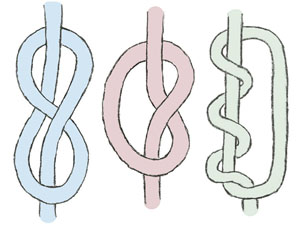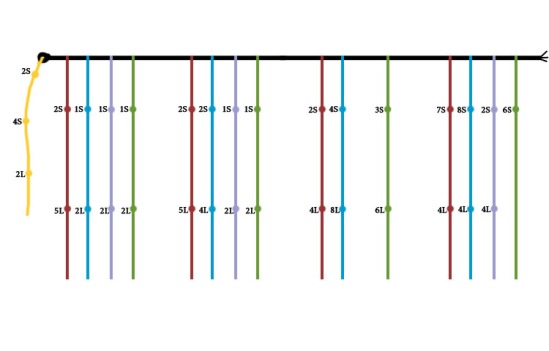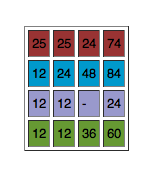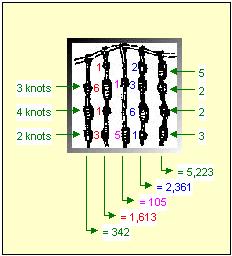The knots on the cords represent numbers. Quipus record numbers using a base-ten positional system, similar to the numbering system we use.
The positional system makes the arithmetic simpler by aligning the numbers. In all the pendant cords, as you move from the end towards the main cord, each successive group of knots represents one higher power of ten.
There are three types of knots: The green one is the long knot (L), the blue one is the eight knot (E), and the red one is the single knot (S). While no knot means zero, most of the times, numbers are represented using single knots. In the unit place (farthest digit from the main cord), however, different types of knots are used. Long knots represented for unit values of 2-9, where the number of turns represents the value of the digit, and the eight knot is used for a unit value of one.
For example, 84 would be 8S-4L on the cord, 321 would be 3S-2S-1E, and 9 would be simply 9L.
Note that the unit place of all the cords lines up. This is to unify the distances between each knot group so that an empty space can be identified as zero. For example the number 1003 would have 1S at the top, and a large space for the hundreds and tens place, and finally a 3L at the bottom of the cord.
This interpretation of Quipus was first proposed by Leland L. Locke at the beginning of the 1900s. This method was believed to be correct because with it, the values on the top cords (which bind many pendant cords together) would contain the sum of the values on the associated pendant.
The spacing of the pendant cords can group certain classes of information together. It may further combine with the difference of the color cords to form simple matrix systems. Below is the figure of a sample Quipu.
The figure above has four groups of cords and each group has identical color patterns except group three missing the purple cord. We can transform this into a matrix below by grouping the values on the same color cords into the same row.
We can now clearly see that the fourth group represents the sum of the previous three groups.
Furthermore, note that most values of the first three groups are the multiples of twelve with the exception of two twenty-five’s on the red cords. This is because the Quipu system can only represent integers and when we try to divide a value sometimes we are left with remainders. In this case when 74 divided by 3, instead of three 24’s and a remainder of 2, we simply spread the remainder to two of the values, resulting in two 25’s and a 24.
We can now look at the dangle cord value of 242, which is the sum of the entries in the fourth group.
This example is actually designed to illustrate the result of the distribution of 242 pieces of corn distributed among four families represented by four different colors. The first group of cords represents the number of corn given to the men, second the women, and third the children. So we can see that the fourth group represents the total number of corn given to each of the family.
The first family (red cord) consists of a man, a woman, the man’s two parents, and two children. The second family (blue cord) is a man, a woman, the woman’s sister, and four children. The third family (purple cord) is just a man and a woman. The fourth family (green cord) consists of a man, a woman, and three children. There are total of twenty people among the four household and 242 pieces of corns. Therefore each person gets 12 pieces and the two elderlies get an extra piece each. We can also see that the third group has no purple cords because the third family does not have any children.
Quipu can be used to record multiple sets of data, or rather, representing hierarchical information. For example, if we want to record the distribution of corns in more than one village, we can attach the main cord of this Quipu with multiple similar Quipus from other villages, forming more complex matrices.






